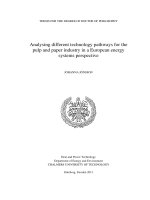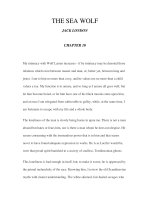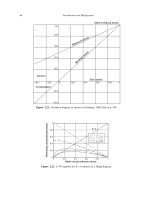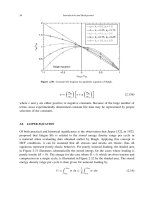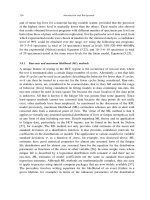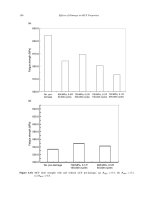A New Ecology - Systems Perspective - Chapter 10 ppsx
Bạn đang xem bản rút gọn của tài liệu. Xem và tải ngay bản đầy đủ của tài liệu tại đây (124.43 KB, 8 trang )
10
Conclusions and final remarks
10.1 ARE BASIC ECOLOGICAL PROPERTIES NEEDED TO EXPLAIN
OUR OBSERVATIONS?
Take a walk on a pleasant May day in a temperate deciduous forest, visit the Serengeti
National Park in Tanzania when the wildebeests are emigrating North, paddle a canoe
through a North-American wetland, or hike the alpine tundra of Austria, whatever your
preference, you will be impressed by the diversity and beauty that nature offers to you. We
know that the diversity of nature is enormous. We can find on the order of 10
7
different
species on earth and they can be combined in ecological networks in an almost infinite
number of ways. We also have a fairly good image of the evolution from 3.8 billion years
ago when the first primitive cells emerged to Homo sapiens with advanced technology of
today: airplanes, computers, Internet, and so on. We could, therefore, turn the question
around and ask: which properties do ecosystems have that explain the diversity, adaptabi-
lity, and beauty of nature and evolution. How can we explain that the interactions between
matter, energy, and information lead to the abiotic and biotic web of life on earth, as we can
observe? We definitely do not need an intelligent designer to come up with a clear and fully
acceptable explanation. This book presents an overview of which systems-based, thermo-
dynamic properties are known to underpin this natural growth and development.
10.2 PREVIOUS ATTEMPTS TO PRESENT AN ECOSYSTEM THEORY
Previously, various attempts have been made to present an ecosystem theory that could
be applied to quantitatively explain ecosystem processes and their responses to distur-
bance and changing impacts. While we cannot cover all the attempts here, we focus on
those based on systems perspectives and thermodynamics.
One of the early pioneers in Systems Ecology, Ken Watt, proposed his theory in the
important work Ecology and resource management in 1968, which opened the way for
greater systems thinking in ecology. In the 1970s B.C. Patten edited four volumes with
the title Systems Analysis and Simulation in Ecology. These four volumes gave the state-
of-the-art of systems ecology at that time and was a useful reference in systems ecology.
All the volumes formed in a sense an early attempt to develop an ecosystem theory.
During the 1980s a number of scientists contributed to an ecosystem theory: H.T. Odum,
R. Ulanowicz, B.C. Patten, R. Margalef, and S.E. Jørgensen to mention a few. For example,
H.T. Odum’s book from this period, Systems Ecology: An Introduction, is probably one of
the best attempts to make a comprehensive ecosystem theory. The discussion of hierarchy
243
Else_SP-Jorgensen_ch010.qxd 3/31/2007 08:27 Page 243
244
A New Ecology: Systems Perspective
theory, allometry, and scaling problems in the 1980s should also be mentioned. T.F.H. Allen
and T.B. Starr in their book Hierarchy, Perspectives for Ecological Complexity (1982) and
R. O’Neill, D.L. De Angelis, J.B. Waide, and T.F.H. Allen in the book A Hierarchical
Concept of Ecosystems (1986) presented hierarchy theory and made it an almost fully
accepted part of ecosystem theory already 20 years ago. Peters (1983) publication of many
allometric principles should also be mentioned in this context. Polunin (1986) edited a book
titled Ecosystem Theory and Application, which was an early attempt to apply ecological
theory to address some of the global environmental issues of the day. The 1980s and early
1990s saw a lot of interest in the Stream Ecosystem Theory (e.g. Cummins et al., 1984;
Minshall et al., 1985; Minshall, 1988; Wiley et al., 1990) which focused on streams as open
systems, controlled primarily by their allochthonous riparian input.
In 1992, S.E. Jørgensen gave an overview of these contributions in his book Integration
of Ecosystem Theories: A Pattern. The various contributions to an ecosystem theory were
very different, but a closer study of the proposed theories revealed that they actually were
different angles and covering different aspects, but largely were consistent, complemen-
tary, and formed as the title of the book indicates a pattern. H.T. Odum’s theoretical con-
tributions to systems ecology were summarized by C.A.S. Hall (1995) in the book
Maximum Power—the Ideas and Applications of H.T. Odum. R. Margalef’s (1997) book
Our Biosphere summarized his contributions to systems ecology. It was based on a well-
balanced cocktail of thermodynamics and ecology. Macroecology by J.H. Brown (1995)
presents from this period a quantitative ecological attempt to explain particularly bio-
geophaphical observations and Reynolds (1997) expands his ideas on theory describing
aquatic habitats.
Patten and Jørgensen (1995) edited the book Complex Ecology—The Part-Whole
Relation in Ecosystems in which 31 systems ecologists contributed, presenting a wide
overview of many different approaches and viewpoints, from quantum mechanic considera-
tions (see herein, Chapter 3), to modeling theory, to network theory (Chapter 5), to feedback
mechanisms (Chapters 4 and 7), to cybernetics (Chapters 4 and 7), and thermo-dynamics
(Chapters 2 and 6). Furthermore, Jørgensen, Patten, and Straškraba have published a series
of papers in the journal Ecological Modelling under the title “Ecosystems Emerging”. The
paper subtitles to date are: (1) Introduction, (2) Conservation, (3) Dissipation, (4) Openness,
and (5) Growth. The remaining papers include: (6) Constraints, (7) Differentiation,
(8) Adaptation, (9) Coherence, and (10) Applications. Similar to this book, these papers are
rooted in thermodynamic laws and basic properties of ecosystems.
Coming from a more biogeochemical perspective, Ågren and Bosatta (1996) pub-
lished Theoretical Ecosystem Ecology—Understanding Element Cycles, which put
emphasis on the importance of carbon and nitrogen cycling in ecosystems and is a com-
monly used textbook in this field.
In 2001, Jørgensen and Marques published “Thermodynamics and systems theory, case
studies from hydrobiology” (Hydrobiologia, 445: 1–10). The paper claimed that we could
develop ecosystem laws and apply them similarly to the application of physical laws in
physics. Similarly, the December 2002 issue of the journal Ecological Modelling (158: 3)
was based on nine papers by different authors invited to show that we could explain
theoretically many papers published in ecology, which themselves were presented as
Else_SP-Jorgensen_ch010.qxd 3/31/2007 08:27 Page 244
observations or rules without any theoretical basis. The nine papers showed successfully
that it is possible to explain theoretically much more in ecology than is generally presumed.
In 2004, Jørgensen and Svirezhev published Towards a Thermodynamic Theory for
Ecosystems. The book covers a major part of the ecosystem theory because thermodyna-
mics is the foundation for understanding many ecosystem processes. Thermodynamics is,
however, a difficult scientific discipline to understand, which unfortunately prevents
wider application. The presented theory is, however, coherent and is able to explain many
ecological observations.
To claim that we have laws providing precise predictive capacity is a simplification in
the sense that ecosystem laws inevitably will be different from physical laws due to the
complexity of ecosystems compared with physical systems. Expressed differently, it will
be much harder to formulate causality in ecology than in physics, but there seems no
doubt that ecosystems have some general properties that can be applied to make predic-
tions and understand ecosystems’ response to perturbations. The focus has, therefore, in
this book been on general processes, properties, and patterns.
10.3 RECAPITULATION OF THE ECOSYSTEM THEORY
This theory integrates and extends the above-mentioned initiatives, building on those con-
tributions. As stated in the first chapter and carried throughout the book, the Ecosystem
Theory presented here rests on seven basic principles we observe in ecosystems:
(1) Ecosystems have thermodynamic openness,
(2) Ecosystem have ontic openness,
(3) Ecosystem have directed development,
(4) Ecosystems have connectivity,
(5) Ecosystems have hierarchic organization,
(6) Ecosystems have complex dynamics: growth and development, and
(7) Ecosystems have complex dynamics: disturbance and decay.
Physical–chemical systems can usually be described by matter and energy relations,
while biological systems in addition need to include information relations. Biological
systems can be characterized using three growth forms: structural (biomass) growth,
network growth, and information growth. The last two growth forms give biological
systems, including ecosystems, possibilities to move further and further from thermo-
dynamic equilibrium and explain also the arrow of evolution. The synergistic effect of
networks gives ecosystems the possibility to utilize available resources better (see
Chapter 5), and thereby move further away from equilibrium. Information can be
copied at almost no energy cost (see Chapter 6) and the increased information yields
better utilization of the available resources to move the system still further from equi-
librium. The first growth form is conservation limited but the second two are not and
are far from their possible limits, as discussed in Chapters 5 and 6.
It was demonstrated in Chapter 9 that the seven ecosystem properties presented in
Chapters 2–8 can be applied to explain a number of ecosystem rules and observations.
Chapter 10: Conclusions and final remarks
245
Else_SP-Jorgensen_ch010.qxd 3/31/2007 08:27 Page 245
It can be concluded that we do not have a complete theory (no scientific discipline has a
complete theory), but one that is adequate to explain many of our observations. Chapter 10
shows that the theory can be applied to assess ecosystem indicators useful in environ-
mental management.
10.4 ARE THERE BASIC ECOSYSTEM PRINCIPLES?
Jørgensen and Fath (2004) have discussed eight basic principles or propositions of
ecosystems, their properties and processes, and Jørgensen (2006) added two more. These
propositions include the thermodynamic laws that are underlying all ecosystem func-
tions, in addition to what is implicitly covered by the general properties of ecosystems in
Chapters 2–7. To the extent possible, it will be mentioned below for each of the proposi-
tions how they are rooted in the seven ecosystem properties presented in Section 10.2.
Interpretation of the propositions has, however, to be subject to the recognition that ecosys-
tems are ontically open—too complex to allow accurate and complete predictions in all
details. Nevertheless, let us try to set up the propositions because they can together with the
properties presented in Chapters 2–7 and applied in Chapters 8 and 9 suggest new avenues
to understand ecosystems:
1. Mass and energy are conserved. This principle is used again and again in ecology
since it allows one to write balance equations at the core of ecosystem modeling, such
as with a basic box-and-arrow diagram in which: accumulation ϭ input–output.
2. All ecosystem processes are irreversible (this is probably the most useful way to
express the second law of thermodynamics in ecology). Evolution and directionality,
implicit in autocatalysis, can only be understood in light of the irreversibility princi-
ple rooted in the second law of thermodynamics. Evolution is a step-wise develop-
ment that is based on previously achieved good solutions to survival in a changeable
and very dynamic world. Evolution has been proceeded in the direction of ever more
complex solutions.
3. All ecosystems are open systems embedded in an environment from which they receive
energy–matter input and discharge energy–matter output. From a thermodynamic point
of view, this principle is a prerequisite for ecosystem processes. If ecosystems were iso-
lated in the physics’ sense, then they would inevitably go to thermodynamic equilibrium
without gradients and without life. This proposition is of course completely consistent
with Chapter 2. It is noticeable that quantification of openness leads to an understand-
ing of many ecological rates rooted in scaling theory and allometric principles.
4. Thermodynamically, carbon-based life has a viability domain between approximately
250 and 350K. It is within this temperature range that there is a good balance between
the opposing ordering and disordering processes: decomposition of organic matter
and building of biochemically important compounds. At lower temperatures process
rates are too slow and at higher temperatures the enzymes catalyzing the biochemi-
cal reactions will decompose too rapidly.
5. Ecosystems have many levels of organization and operate hierarchically. This prin-
ciple is used again and again when ecosystems are described: atoms, molecules,
246
A New Ecology: Systems Perspective
Else_SP-Jorgensen_ch010.qxd 3/31/2007 08:27 Page 246
cells, organs, organisms, populations, communities, ecosystems, and the ecosphere.
Hierarchy theory has been presented in Chapters 2, 3, and 7, and has been widely
used to explain ecological observations.
6. Carbon-based life on earth has a characteristic basic biochemistry which all
organi-sms share. It implies that many biochemical compounds can be found in all
living organisms. They have, therefore, almost the same elemental composition
derived from approximately 25 elements (Morowitz, 1968). This principle is widely
used when stoichiometric calculations are made in ecology, i.e. an approximate
average composition of living matter is applied. The proposition is able to give a
biochemical explanation of feedback.
7. Biological processes use captured energy (input) to move further from thermodynamic
equilibrium and maintain non-equilibrium states of low entropy and high exergy rela-
tive to surroundings. This is just another way of expressing that ecosystems can grow.
Svirezhev (1992) has shown that eco-exergy of an ecosystem corresponds to the
amount of energy that is needed to degrade the system. This proposition is consistent
with the properties presented in Chapters 4 and 6.
8. No ecosystem organism exists in isolation but is connected to other organisms and its
abiotic environment. Simply put, this states that connectivity is a basic property that,
through transactions and relations, binds ecosystem parts together as an interacting
and often integrated system. It can be shown by observations and ecosystem network
calculations that the network has a synergistic effect on the components: the ecosys-
tem is more than the sum of the components (see e.g. Patten, 1991; Fath and Patten,
1998). The proposition is completely consistent with the content of Chapter 5.
9. After the initial capture of energy across a boundary, ecosystem growth and develop-
ment is possible by (1) an increase of the physical structure (biomass), (2) an increase
of the network (more cycling), and then (3) an increase of information embodied in the
system. All three growth forms imply that the system is moving away from thermody-
namic equilibrium (Jørgensen et al., 2000), and all three growth forms are associated
with an increase of (1) stored eco-exergy and (2) the energy throughflow in the system
(power). When cycling flows increase, the eco-exergy storage capacity, the energy use
efficiency and space–time differentiation all increase (Ho and Ulanowicz, 2005).
When the information increases, the feedback controls and autocatalysis become more
effective, specific respiration decreases, and there is a tendency to replace r-strategist
species with K-strategists, which means less energy is wasted on reproduction. When
earth systems (physical and biological) capture approximately 75% of available solar
energy, it is not possible to increase this capture further. The same is true for limiting
elements. Under these conditions ecosystems cannot benefit further from growth Form
I and must graduate to growth Forms II and III. Thereby, the efficiency of exergy uti-
lization is increased. This description is in accordance with Margalef (1991, 1995): the
first stages proceed rapidly with an apparently wasteful use of available energy; later a
higher efficiency along a defined direction occurs, because of competition, in the
frame of natural selection. Growth Form I is constrained by the conservation of energy
and matter, while the two other growth forms are not following the conservation laws.
In ecosystem succession the information is transferred from the present to the future
Chapter 10: Conclusions and final remarks
247
Else_SP-Jorgensen_ch010.qxd 3/31/2007 08:27 Page 247
and the shift is manifested in a historical way that has many aspects. One of these, the
production and accumulation of biomass, prevails at the beginning, and this is often
described as “bottom up” control. Later, the high trophic levels take more control, and
“top-down-control” becomes more apparent. This proposition has been presented in
Chapter 6 and partly in Chapters 4 and 7. It has furthermore been applied several times
in Chapters 8 and 9.
10. An ecosystem receiving solar radiation will attempt to maximize eco-exergy storage,
ascendency, or maximize power such that if more than one possibility is offered, then
in the long-run the one which moves the system furthest from thermodynamic equilib-
rium will be selected. Eco-exergy storage increases with all three growth forms—see
above. When an ecosystem develops it can, therefore, apply all three growth forms in
a continuous Darwinian selection process. It is intuitively obvious why the nested
space–time differentiation in organisms optimizes thermodynamic efficiency as
expressed in the tenth proposition because it allows the organism to simultaneously
exploit equilibrium and non-equilibrium energy transfer with minimum dissipation
(Ho and Ulanowicz, 2005). This proposition has been touched on in Chapters 4, 6,
and 7 and been applied several times in Chapters 8 and 9.
As seen from this short overview of the ten propositions they may be considered a use-
ful organization of the basic system ecology needed to understand the ecosystem reactions
and processes. The organization in propositions are different from the basic properties that
were applied as the fundament for the presentation of our “New Ecology—A System
Approach” shown in Chapters 1–9. It is, of course, not surprising that we need different
descriptions of ecosystem processes and responses. Ecosystems are complex systems as
touched on several times throughout the book. So, how many different descriptions do we
need to describe ecosystems when we consider that a simple physical phenomenon as light
requires two descriptions, as waves and as particles?
We, the nine authors, conclude, however, that we do have an ecosystem theory, that
can be presented in different ways but under all circumstances can be used to explain and
understand ecological observations, properties, and processes (Chapter 8) and even be
applied in environmental management (Chapter 9). The theory should be considered one
of the first attempt to present an (almost) complete ecosystem theory. It is most likely that
it will changed in the coming years as we gain experience by using it, but it can anyhow
today as hopefully demonstrated for our readers be applied to explain ecology and to
develop a good environmental strategy for ecosystem management. Further development
of an ecosystem theory in system ecology will only be possible by trying to use theoreti-
cal approaches in ecology and environmental management. We, therefore, encourage all
ecologists and environmental managers to apply the presented theory.
10.5 CONCLUSION
The earth is a non-isolated system. There is almost no exchange of matter with the outer
space (the earth loses a little hydrogen and receives meteorites). To be able to utilize the
matter many times during the evolution or from one year and decade to the next, cycling
248
A New Ecology: Systems Perspective
Else_SP-Jorgensen_ch010.qxd 3/31/2007 08:27 Page 248
is necessary. Cycling implies that the ecosystem components are linked in an interacting
network (Chapter 5).
Ecosystems must be, as the earth, non-isolated because otherwise they could not receive
the energy needed to maintain the ecosystems far from thermodynamic equilibrium and
even move further away from thermodynamic equilibrium. Ecosystems are actually open
systems (Chapter 2) because they need to exchange at least water (precipitation and evapo-
ration) with their environment. In addition, it is practical that suitable solutions (for instance
species with new emergent properties that facilitate survival under a combination of new
and emergent conditions) in one ecosystem can be exported to other ecosystems. Moreover,
it is easy to observe that ecosystems are open systems.
The flow of energy from the sun to the ecosystems is also limited. It is important that an
ecosystem captures as much sunlight as possible to cover its energy needs. Therefore,
ecosystems, with increased biomass, can increase net primary productivity. But even the
best photosystems can only capture a certain part of the solar radiation, which anyhow is
limited to about 10
17
W on average. Therefore moving further away from thermodynamic
equilibrium requires that an ecosystem develop better utilization of the exergy that it is able
to capture. Network development, where the components have been fitted together, pro-
vides improved exergy efficiencies (Chapters 4 and 5). Another possibility is to increase
information in the form of better process efficiencies (Chapter 6). Increased sizes of the
organisms imply also that the exergy lost for respiration decreases relatively to the biomass
(Chapter 2).
While matter and energy flow limit evolution, the amount of information is far from
its limit. It is, therefore, understandable that information embodied in genes and in eco-
logical networks has increased throughout evolution (Chapter 6).
On the one side, we do know the characteristic ecosystem response to changed condi-
tions and can make predictions. On the other side, ecosystems are so complex that very
accurate detailed predictions always will be impossible and “surprises” should always be
expected; see Chapter 3.
The development of the life forms that we know from the earth has been possible
because the earth has the elements that are needed to build the biochemical compounds that
explain the life processes. It includes water that is an ideal solvent for biochemical reac-
tions. In addition, the earth has the right temperature range that means that the biochemical
reactions proceed with a certain rate and that the decomposition of particularly proteins is
moderate. The right balance between formation and destruction of high molecular proteins
that are the enzymatic compounds controlling the life processes is thereby obtained.
The life processes take place in cells, because they have a sufficiently high specific sur-
face to allow an exchange rate with the environment that is suitable. Cells are, therefore,
the biological units that make up organs and organisms. Nature must, therefore, use a hier-
archical construction (Chapters 2, 3, and 7): atoms, molecules, cells, organs, organisms,
populations, communities, ecosystems, and the ecosphere. The addition of units in one
hierarchical level to form the next level gives the next level new and emergent properties
(Chapters 3 and 7).
The variability of the life conditions in time and space is very high (Chapter 6). When
an ecosystem has adapted to certain conditions, it can still be disturbed by catastrophic
Chapter 10: Conclusions and final remarks
249
Else_SP-Jorgensen_ch010.qxd 3/31/2007 08:27 Page 249
events. Ecosystems have due to their properties (see all the chapters but particularly
Chapter 7) the adaptability and flexibility to meet these changed conditions and still
maintain the system far from thermodynamic equilibrium. The disturbances call for new
and creative solutions for life to survive. Disturbances may therefore also be beneficial
in the long term for ecosystems (Chapter 7).
We can explain the ecosystems, their processes and responses, and evolution by the
properties presented in this book. The discussion throughout the book has clearly shown
that the properties are sufficient and the discussion in this last section has demonstrated that
the properties are also necessary. It may, however, not be the only possible explanation to
life in general. We cannot exclude that we will find other life forms somewhere else in the
universe, for instance based on silica or carbon but with another biochemistry, better suited
maybe for a different situation. The properties presented above are, however, very consis-
tent with both direct and indirect observations, which render them a good basis for an
ecosystem theory applicable on Earth. Chapters 8 and 9 have, not surprisingly, shown that
the ecosystem theory presented in this book can be used to explain other ecological rules
and hypotheses and have potential for application in environmental management.
250
A New Ecology: Systems Perspective
Else_SP-Jorgensen_ch010.qxd 3/31/2007 08:27 Page 250
